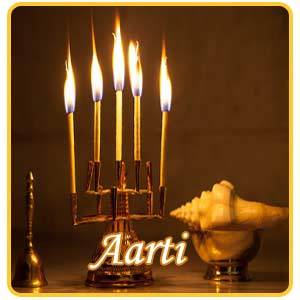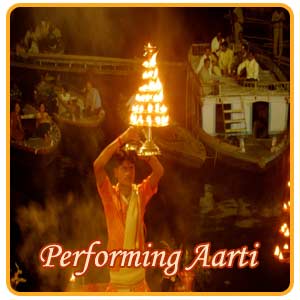 Concept of Offering Aarti
Concept of Offering Aarti
The concept of offering Aarti is said to have originated from the fire rituals or homa of Vedic period in India.Aarti is mainly offered for deities where wicks are kept soaked in purified butter and then lighted. The custom of Aarti is not only performed to God and other forms of life but also to other inanimate forms like vehicles or electronic gadgets so that it excels in its performance and help the performer to do his best. This is another way of worshipping and respecting the object. It can be noticed that when aarti is offered to God at the end it is waved to all the viewers present there which is mainly to show that each one belongs to God and they are an indispensible part of God and thus they show their respect by taking the aarti and bowing down to it. According to Sanskrit the word "Aarti" means complete love where the word "Aa" stands for complete and "rati" means love. Thus Aarti is defined more precisely as a steady and a complete love of a person extended to God. The term Aarti also means the devotional Hindu song which is sung during the performance of Aarti to God.
 Aarti is Done with Total Dedication
Aarti is Done with Total Dedication
-When Aarti is sung the pooja or the offering of aarti is done with total dedication of esteem, feeling of profound love and admiration and contemplation of thought towards God. Thus, one's entire subsistence and all facets of material creation are symbolically offered to the Lord through the aarti ceremony. Aarti is mostly performed at least twice or thrice a day especially towards the end of the bhajan session. The reason or the purpose behind the performance of Aarti is with an intention of respecting the deities in humbleness and gratefulness and thus the devotees become deeply immersed in God's divine form. Aarti is not only performed in the temples but also at home. Aarti generally signifies the five elements of the universe namely the ether (akash), wind (vayu), fire (agni), water (jal), and earth (pruthvi).
 The process of doing the Aarti
The process of doing the Aarti

 Aarti is clubbed with Singing
Aarti is clubbed with Singing

Aarti is first done in the clockwise direction and after every second or third circle it is waved back and again continued to be waved in the clockwise direction. The main idea behind this motion of Aarti is that it signifies our daily activities which whirl round the God, a center of our life. It can also be taken that aarti is offered to keep God in focus on all the activities we do and strengthen the relation or the belief that everything is secondary only to God for he is the supreme being. Once each individual realize this they get the power to face any unexpected sorrow in their life.
 The meaning behind doing Aarti
The meaning behind doing Aarti
- There are various understanding for Aarti- like it also represents that all of us come only under the divine control of God, which helps in maintaining one's ego down and keep up humility in spite of how high he or she is placed. The custom of Aarti acts as a reminder to be alert so that no worldly pleasure and wishes can overcome the person. This is highlighted by the lighted wicks or the flames during Aarti which removes darkness and keep the person in a bright real world.Performance of aarti is one of the sixteen steps which have to be performed in shodasha upachaara or the pooja of ritual. It is not only accompanied by singing of Aarti songs but also most of time accompanied by playing of musical instruments and clapping which is more of bhajan form. Aarti is also referred to as Mangala Niraajanam and during this process the devotees get engrossed by either a silent or a loud chanting of prayer and keep their eyes fixed on the illuminated deity of the Lord. We get a feeling of additional power in our prayers and the Lord seems to exhibit a special beauty at that time. Apart from lighting a wick for Aarti it is also done with the help of lighting camphor which has spiritual significance related to it. Camphor burns out completely without leaving any trace of it and also at the same time emanates a lovely fragrance. This is compared to an individual's life where the person's knowledge is lit by fire and the truth or the Lord in us is revealed to the world vanishing away our ego and creates a sense of individuality that keeps us separate from the Lord.
 Aarti brings us in communion with the God
Aarti brings us in communion with the God

After waiting for all the rituals to happen and once when the Aarti is shown and the deity gets illumined we close our eyes involuntarily which will take us deep inside the God. This action mainly denotes that each of us is a temple of the Lord and we hold the divinity within. Towards the end of Aarti when it is offered to us we take the offering and put it back on our eyes and head only to ensure that the light which has illumined the lord may also open up our divine vision so that our thoughts become noble and beautiful.
 Aartis in the Hindu Temples are Performed by the Priest
Aartis in the Hindu Temples are Performed by the Priest
The philosophical extension for Aarti is that it states the natural sources of light includes the sun, moon, stars and fire and the God is the creator of all these and it is only because of him all these extraordinary phenomenon exists. The Sun is supposed to be the presiding deity of the intellect; the moon, that of the mind; and fire, that of speech and in turn the Lord has the supreme power of ruling all these heavenly bodies. Thus as we light up the Lord with flame of the aarati, we turn our attention to the very source of a light, which symbolizes knowledge and life. The Aartis in the Hindu temples are performed by the priest and the first one which is performed in the morning is known as 'mangala-arati', this is followed by another aarti in the later morning and one at noon time and the final one is performed at sunset.The common Aarti hymn which is sung or chanted at the time of performing aarti is as follows, "Na tatra suryo bhaati na chandra taarakam Nemaa vidyuto bhaanti kutoyamagnih Tameva bhaantam anubhaati sarvam Tasya bhaasa sarvam idam vibhaati" He is there where the sun does not shine, nor the moon, stars and lightning. Then what to talk of this small flame (in my hand) ! Everything (in the universe) shines only after the Lord, and by his light alone are we all illuminated.


